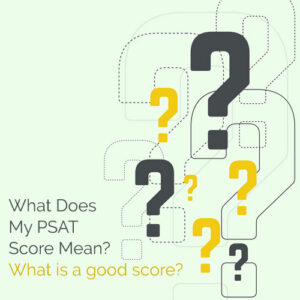PSAT Scores Are Back: Now What?
- November 21, 2017
- PSAT, SAT
- Posted by James Maroney
- Comments Off on PSAT Scores Are Back: Now What?
Members of the class of 2020 and 2021 will be able to access their PSAT  scores online on December 9. After seeing their son or daughter’s scores, many parents will ask the same question: What do these mean?
scores online on December 9. After seeing their son or daughter’s scores, many parents will ask the same question: What do these mean?
Parents who have an older child may find these scores strangely unfamiliar. The scores have gone back to the future and returned to the 1600 scale instead of the 2400 scale. There are two scores on the test now: A math score and an evidence based reading and writing score. Each of these is scored from 160 to 760, and those scores are combined to give you a score from 320 to 1520. A PSAT score is on the same continuum as the SAT, so your score reflects what you would achieve on the SAT if taken that same day. The reason the PSAT doesn’t go to 800 in a section, like the SAT, is that the upper level content (those 800 level questions) isn’t on the PSAT. It isn’t immediately obvious how the number of right answers a student received connects to their final score because the PSAT and the SAT are graded on a scale. First, a student gets a raw score based on how many questions they answered correctly. That raw score is then calculated into a scaled score, which is the score out of 800. The reading and writing raw scores go through additional step of being converted from a raw score to a sub-score from 8 to 36. Those two subscores are then put together to get the final scaled score out of 720. There will be a number of other kinds of sub-scores listed, but colleges are mainly focused on the total score out of 1600 for the SAT. Whew! Sound complicated enough for you? Don’t worry – look out for our next article, which will talk more on how to use those scores to create a preparation plan.
The PSAT is a good predictor of how student will do on the SAT. So what is a good score? How do you know if your student has one? As with most issues related to college planning, the answer is “that depends”. As far as scores are concerned, it depends on where you would like to apply to college. According to the College Board, the national average score for 2017 is a 1083. To give you an idea of score ranges for a few different colleges, I will list the middle range for a few popular schools. The bottom number is the number that 25% of the accepted students scored below, and the top number is the number that only 25% of the accepted students scored above. The scores in between are what they call the “middle fifty”:
UConn – 1220 to 1410
University of New Haven – 1050 to 1240
Yale – 1490 to 1600
Trinity – 1200 to 1440
Southern Connecticut – 920 to 1120
If a student finds that there’s a gap between the score ranges for the colleges where the student would like to apply and their score, then you may want to consider some form of test preparation before taking the SAT. The SAT is offered 7 times a year on Saturdays. The state of Connecticut will be giving the SAT to every public school junior in on March 21. That means students and families should start preparing soon. With approximately 3 months to the next major test, students should start by reviewing the PSAT and looking over all of the questions that they had wrong. The should see if they just made careless mistakes, or if they have some particular area of weakness. Students who are self-motivated can find a number of resources for extra practice. I highly recommend all students take as many of the free College Board practice tests as possible. If self-study isn’t enough, then you should consider either a group class or private tutoring to help prepare the student for the SAT. As I’ve said before, schools want to see that you are as prepared as possible each time you take the test.

